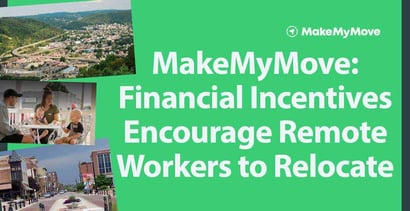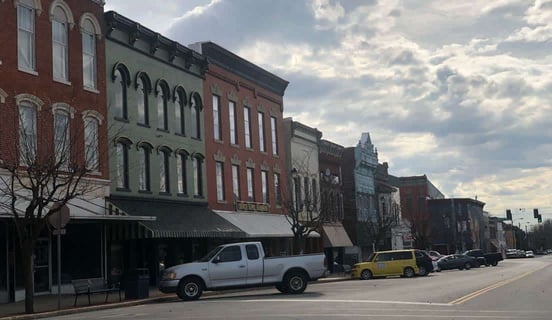
In a Nutshell: Since 2020, the number of remote workers in the U.S. has exploded. That’s why many towns and cities with smaller populations have begun to offer relocation stipends and other incentives to encourage workers to consider relocation. At the intersection of these two trends is MakeMyMove, a platform where remote workers can discover towns and cities they may not otherwise have known about — and the incentives they offer. MakeMyMove has already helped thousands of virtual employees relocate to cities that offer lower costs of living, more space, and more robust communities. And the platform aims to expand its influence as remote work appears to be here to stay.
Years before 2020, Indiana had been losing its workforce for the first time in the state’s history. That’s when Evan Hock started thinking about a more innovative way to address the shrinking talent pool.
“What if we use technology and targeted marketing to essentially build the addressable talent pool for the state of Indiana, and then go out and recruit them to come back?” he said.
So Hock co-founded MakeMyMove, a platform to connect remote workers with Indiana’s offerings and incentives to encourage them to relocate.
During the COVID-19 pandemic, however, Hock and his team realized that this goal wasn’t expansive enough. Suddenly, there were tens of millions of people around the country who could choose where they wanted to live. Never before had so many workers been untethered to their employer’s location.

So, in late 2020, Hock and his team decided to market Indiana communities to a larger pool of remote workers with the goal of attracting new residents. The team asked itself: If people didn’t have to live somewhere specific for their jobs, were they willing to move?
Over the next two years, the team discovered that the answer was, “Yes.”
“They’re choosing for all kinds of interesting reasons, whether they’re trying to find places that are more affordable, or somewhere they can have more space or be close to the amenities that they like. It’s a personal choice for them,” said Hock, who also serves as MakeMyMove’s Chief Operating Officer.
MakeMyMove has also expanded beyond Indiana, highlighting primarily smaller communities in the Midwest and Northeast. The platform also includes offers for relocation stipends ranging from $5,000 to $20,000 to encourage remote workers to consider more places. Communities provide these funds to encourage applicants to choose their towns.
“Our job is to play matchmaker and help facilitate the move,” Hock said.
Explore 90+ Communities Around the Country
When MakeMyMove started out, about 20 communities in the US were offering these incentives. Today, it’s closer to 90. As more local governments and local economic development corporations fund relocation programs, more places are hopping on the trend.
“It was hard to get started, but once a handful of communities were doing it, a lot of them felt a fear of missing out. So, we see a lot more communities joining the fray,” Hock said.

Hock said he has been surprised by how relocators make their decisions about where to move. He thought most people would have specific places in mind. While some users on the site have specific places they’re willing to live, far more of them move to what he describes as a “profile” of a place.
“That profile might have a certain cost of living, it might be in a particular region, it might be close to certain amenities. We found that within that profile, people are willing to move around,” he said.
College towns, for instance, are popular because they simultaneously offer a low cost of living and many activities. A handful, including Stillwater, Oklahoma, West Lafayette, Indiana, and Bloomington, Indiana, are listed on the site.
Other places, like West Virginia, have been successful because some relocators are looking for places close to mountains and rivers. The state also offers a $20,000 incentive, more than half of which is cash.
Rochester, New York has been a strong performer, since it’s a recognizable place, close to a river, and also offers a $20,000 incentive.
“All these programs have something special about them. There’s something in the offer and in the community they’re pitching and finding resonance with an audience,” Hock told us.
A Competitive Marketplace for Residents
Like Indiana, many states, cities, and towns are losing residents. So, programs that compete for the ever-growing remote workforce are becoming more commonplace.
“For decades, companies have wielded this power of demanding employees to move places, and we’re seeing that purchasing power has shifted to the consumer. Folks that are willing to bring themselves and their income and their families are just as valuable to those local communities,” Hock said.
In turn, the MakeMyMove team is seeing competition to attract remote talent like never before.
Communities are starting to figure out how to differentiate themselves, and the organization helps them identify the best ways to do that.
“We provide a way to promote their programs. For many communities, we were involved in setting up their programs and securing funding. But now, those programs are completely supported by the communities themselves,” Hock said.

The high watermark of all these programs is, by far, Tulsa, Oklahoma. The city now recruits around 1,000 new residents each year using the MakeMyMove platform.
Greensburg, Indiana, a small rural community, has also been successful. The town developed a welcoming program that helped new residents get settled — and in less than a year, found more than 2,500 residents interested in relocating to the area.
Others have more modest responses.
“But even when you can move just five or six people, these folks bring their income and their taxes, so they’re valuable to these local communities that maybe historically have had trouble growing their economies,” Hock said.
Simplifying Relocation and Expanding Options
When would-be relocators use MakeMyMove, they are first asked to consider what they want in the next place they live. Users typically want to be able to level up their lifestyles in a variety of ways, including being able to afford to go out more often. Some want to own land, while others want to live close to airports.
“We see a lot of communities that are within reasonable driving distances to big metros,” Hock said.
The website allows users to apply to more than one program. Some have three or four places they may want to live, so they apply to several. Many of these programs have limited capacity and only accept a small number of new residents each year.
“We do make recommendations once you get a sense of where you want to go. But it’s a shopping experience more than anything. If people are trying to find the place that’s right for them, our job is to help them make that decision,” Hock said.
In its less than three years in operation, MakeMyMove has already helped thousands of remote workers find new places to call home. At the same time, communities that may have otherwise lost populations are attracting new residents.
Hock and his team have plans to make the platform even more functional for communities and remote workers. For instance, they’ve recently started notifying users when a new program fits their needs and interests.
Hock said he remains excited to help relocators choose new places they wouldn’t have otherwise known about.
“They read about it on the site, and they’re like, this place is pretty awesome,” he told us.




